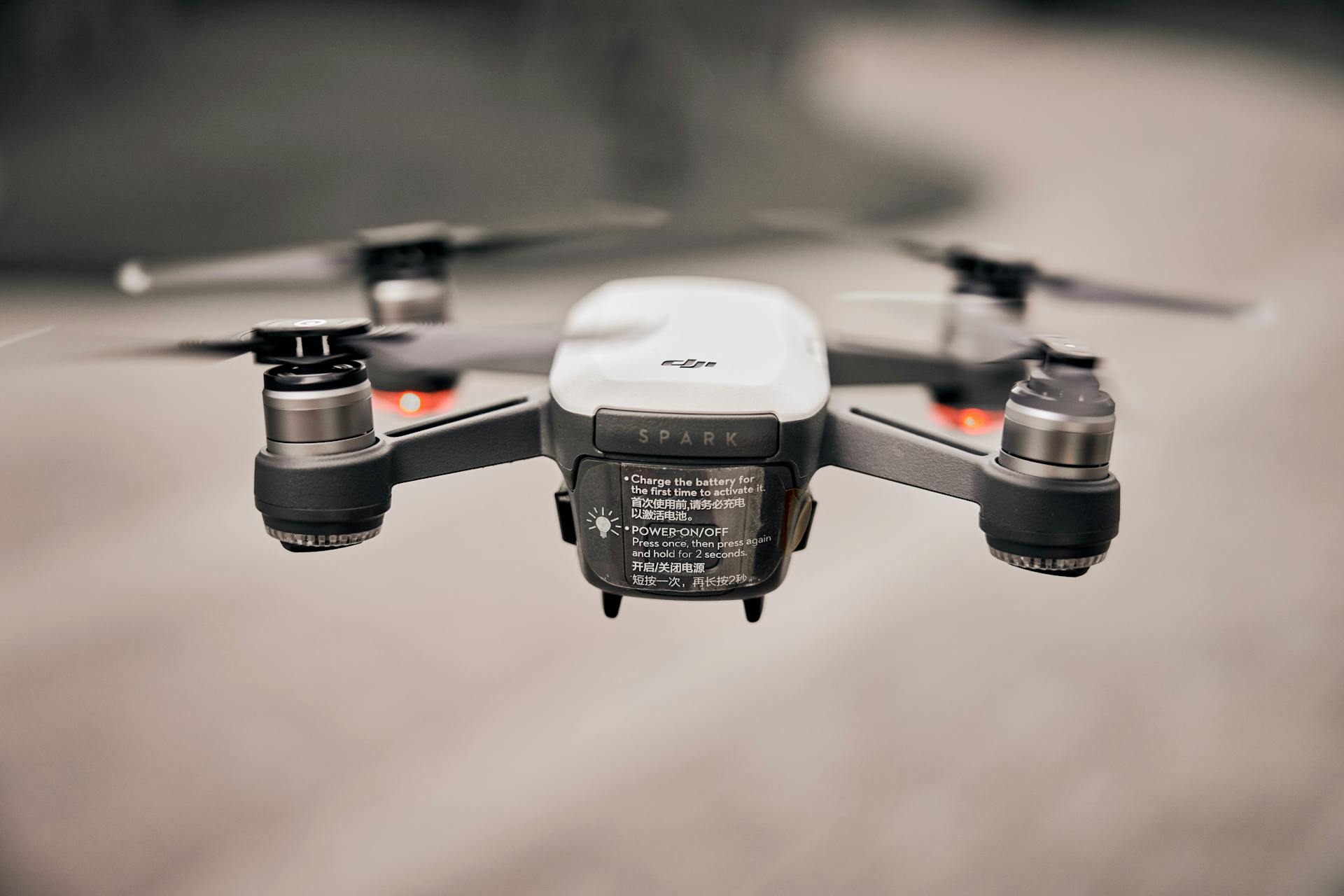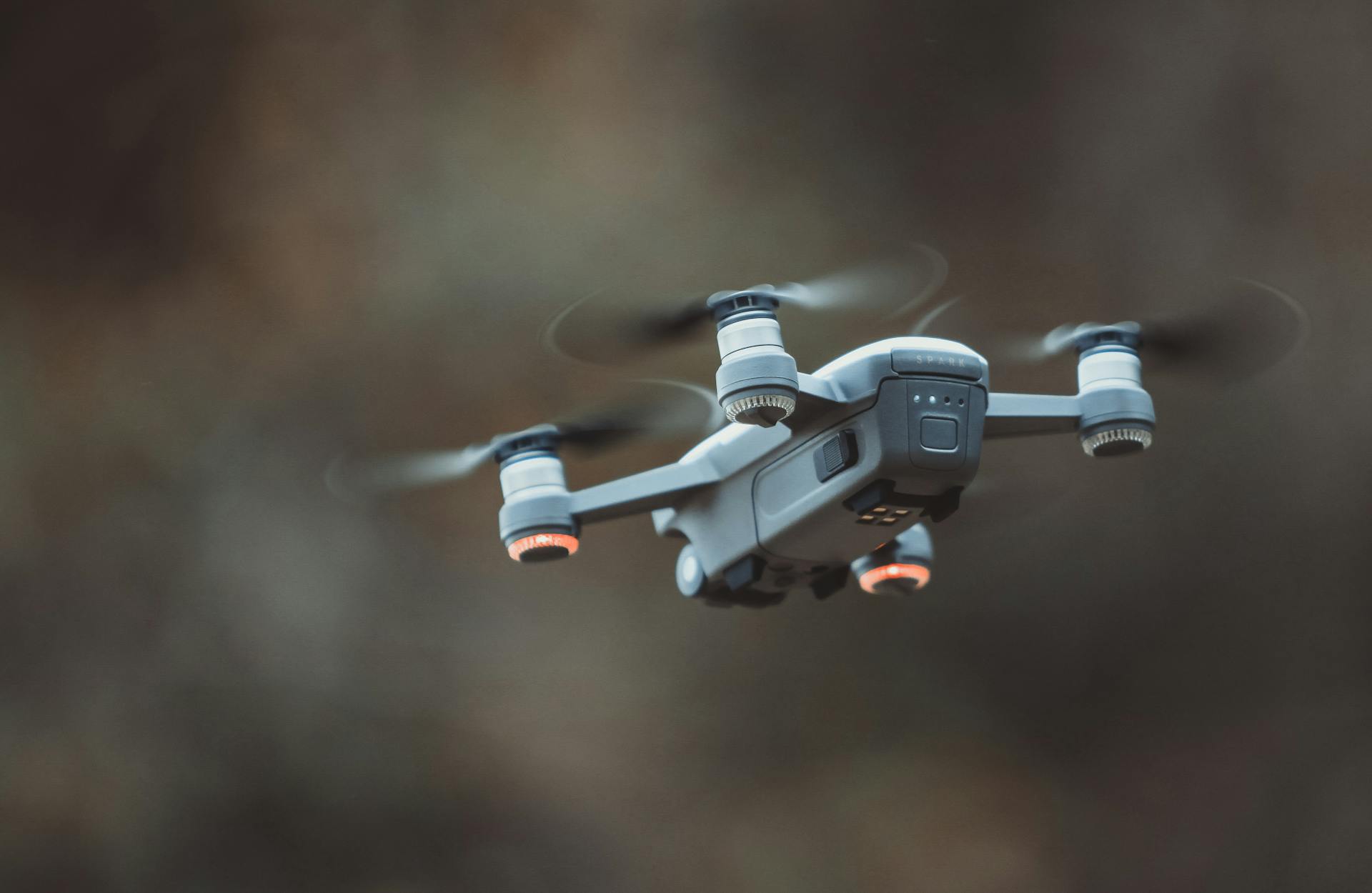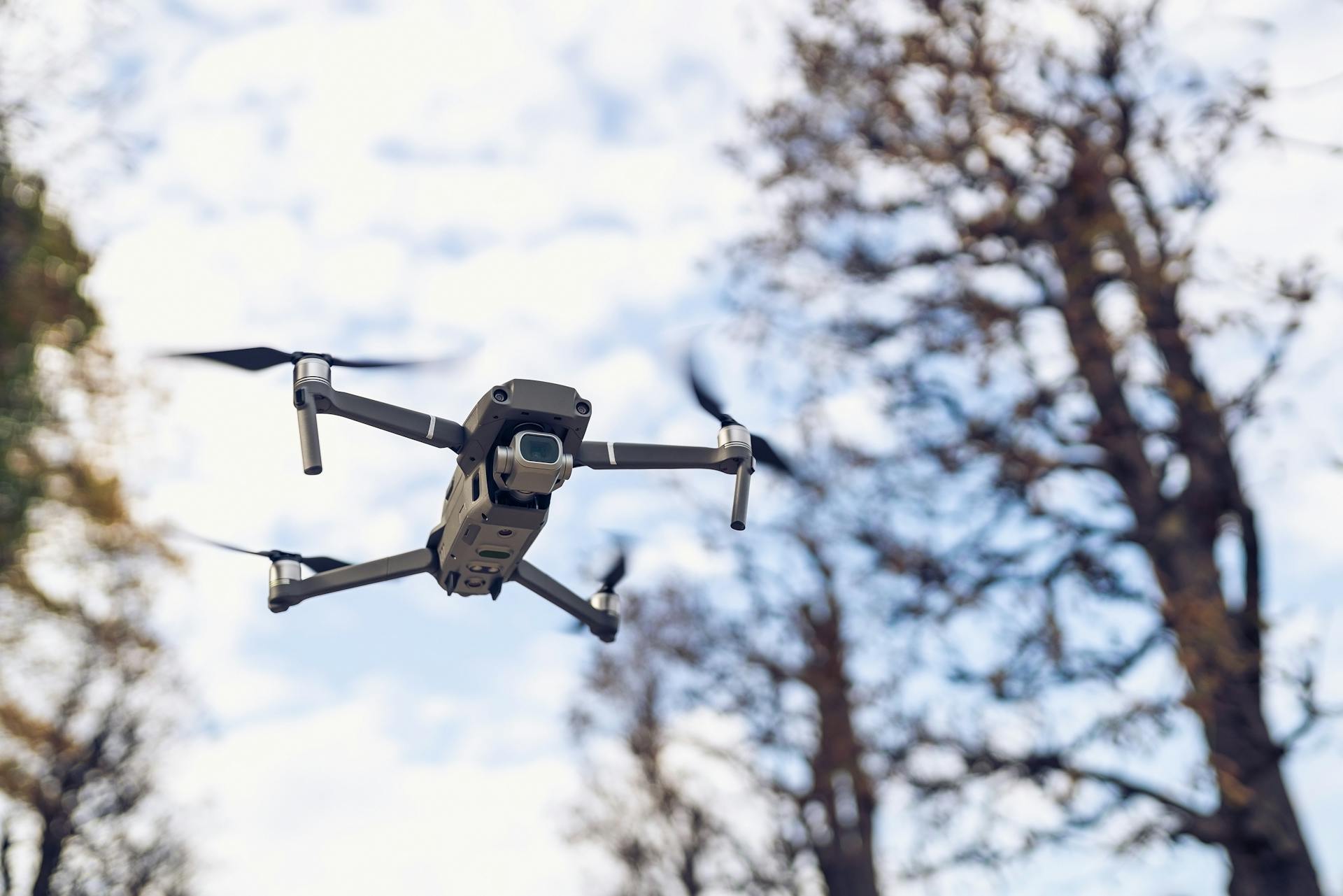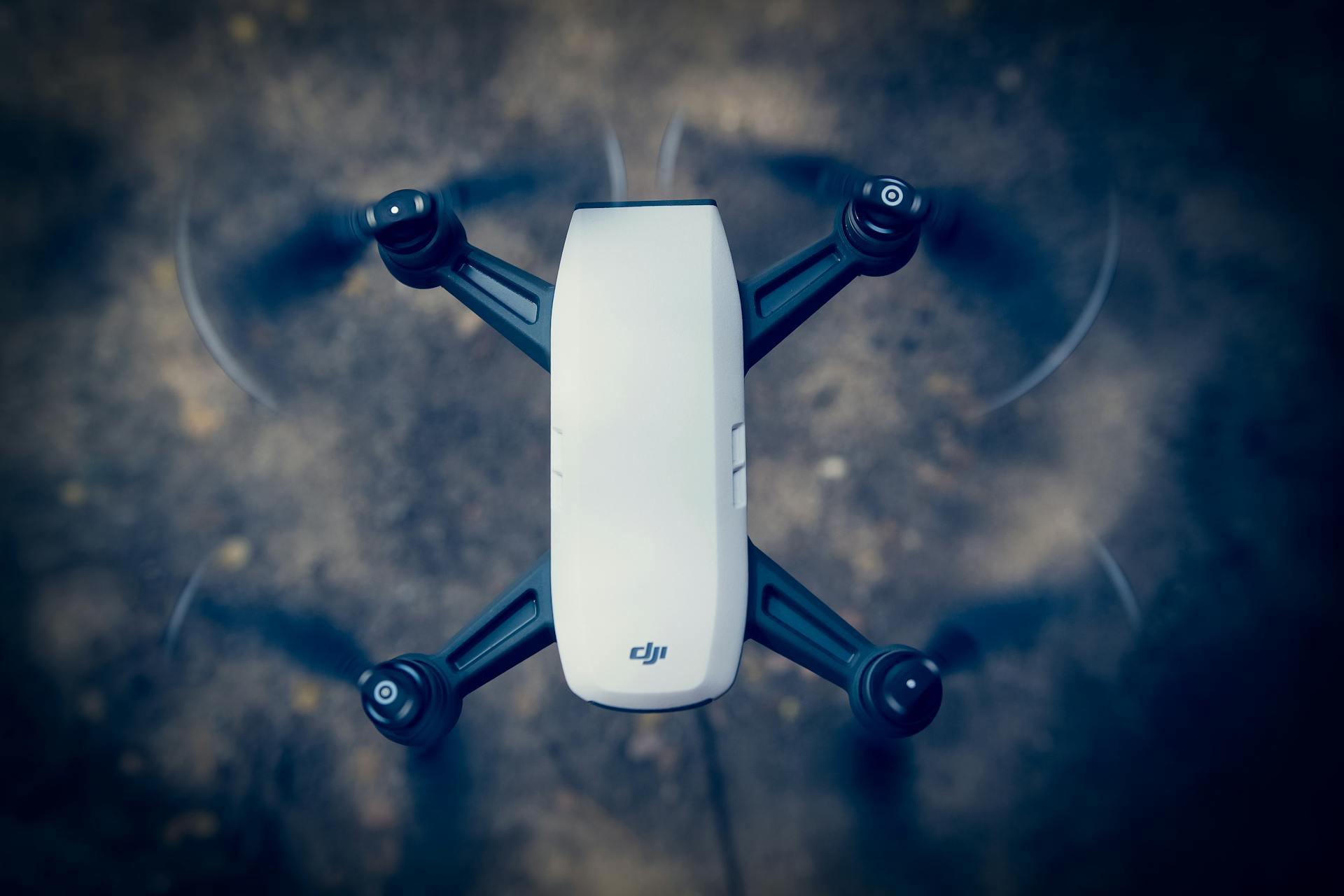
Let's break down the basics of quadrotor motors. A quadrotor motor is typically composed of four brushless DC motors, each with its own propeller.
The motors are connected to a control system that regulates their speed and direction. This system ensures stable flight by making adjustments in real-time.
The quadrotor's frame is designed to withstand the stresses of flight, with a sturdy structure that can support the weight of the motors, electronics, and other components.
Quadrotor Motor Basics
A quadrotor motor is made up of two main parts: the stator and the rotor. The stator is the stationary part of the motor, while the rotor is the rotatory part.
The stator size is based on its diameter and height, and is usually denoted by a size code, such as 2207, which means the stator is 22mm wide and 07mm high.
The KV of a motor refers to the speed at which it rotates for every volt applied to it, theoretically.
Motor Design and Components
Understanding motor design is essential for building or designing quadcopters. You need the correct quadcopter motor configuration to ensure stable flight.
A correct motor configuration involves matching propellers with the motors. This is crucial for achieving the right thrust and balance.
The motor thrust is affected by the payload, so you need to consider the weight and size of the payload when designing the motor configuration.
Importance of Flight Mechanisms
Understanding how a quadcopter works and flies is crucial for troubleshooting issues with motors or propellers. With a small bit of experience, flying a quadcopter becomes automatic, but knowing the mechanics behind it helps you locate problems.
You move the sticks on the Remote Controller Ground Station, which send the quadcopter in whichever direction you want it to fly. This happens without needing to think about what the motors or propellers are doing.
Understanding quadcopter propeller design and motor thrust is essential for making changes to your quadcopter, such as removing the camera and installing another payload. This requires different motor thrust.
A different payload will have an effect on the control, flight, and balance of the drone. This means you need to adjust the motor configuration accordingly.
Shaft
Hollow shafts reduce the weight of the motor, but they're less durable during crashes.
Newer motors often use hollow shafts to save weight, but this design choice has its drawbacks.
Solid shafts, on the other hand, are more durable but heavier.
Replacing a hollow shaft requires replacing the whole rotor of the motor, which can be a significant expense.
For budget builders, hollow shafts can be a bad thing due to the cost of replacement.
Air Gap
The air gap between the stator and rotor is a critical design element in motor performance. A smaller air gap allows the stator to slice through magnetic fields more efficiently, resulting in higher thrust.
As the air gap decreases, the motor's efficiency in converting current increases. This is because the closer proximity of the rotor to the stator enables better magnetic field interaction.
A smaller air gap means a more efficient motor, but it also means a more complex design and manufacturing process. The air gap must be carefully controlled to achieve optimal performance.
The closer the rotor is to the stator, the more efficient the motor is in converting current. This is a fundamental principle of motor design that underlies many modern applications.
Motor Performance and Efficiency
A high efficiency motor is crucial for a quadrotor, and it's calculated by dividing the thrust produced by the power produced, measured in grams per watt (g/w). The higher this ratio, the more efficient the motor is.
The efficiency of a motor varies across the throttle range, so it's essential to consider it from 0% to 100% throttle. Some motors excel at low throttle, while others shine at high throttle.
A motor's torque, or spinning force, significantly affects performance and responsiveness. Higher torque motors are more responsive but can suffer from bad oscillation, which is hard to eliminate even with PID tuning.
A motor's torque speed curve is a graph that shows speed decreasing as torque increases. The area under the curve represents the mechanical power produced by the motor. Peak efficiency doesn't occur at peak power, and increasing mechanical power beyond peak efficiency requires more electric power.
Efficiency
Efficiency is a crucial aspect of motor performance, and it's essential to understand how it's calculated. The efficiency of a motor is calculated by dividing the thrust produced by the motor at 100% throttle by the power produced by the motor.
This is measured by grams per watt (g/w), and a higher ratio indicates a more efficient motor. Motors can be efficient in different parts of the throttle curve, with some being more efficient at lower throttle and others at higher throttle.
A perfectly efficient motor would produce just as much mechanical power as the electric power it consumes, but in reality, there's always some loss. Peak efficiency does not occur at peak power, and operating a motor beyond its peak efficiency can lead to diminishing returns.
The operating point is an essential concept to understand, as it defines a motor's performance. This point changes with different propellers and payloads, and it's crucial to match a motor to a propeller that suits its operating point.
Current Draw
Current Draw is a crucial factor in determining the Quadcopter ESC size required for a particular motor. A 1104 motor draws 10A max at 100% throttle, whereas some 2306 motors draw 40A max at 100% throttle.
To select the right ESC, you need to consider the motor's current draw at 100% throttle and add 20% to the rating. For example, if a motor draws 30A max at 100% throttle, an ESC rated for 36A constant current would be ideal.
There's also the burst rating of an ESC to consider, which is the maximum amps of current it can handle for a short period of time without damaging itself. This is important to ensure your ESC can handle the motor's peak current draw.
Here's a rough guide to help you choose the right ESC size based on motor current draw:
Keep in mind that these are general guidelines, and it's always better to err on the side of caution and choose a slightly larger ESC to ensure safe operation.
Temperature
Temperature plays a significant role in motor performance and efficiency. Motors exposed to prolonged heating can lose their magnetic field strength over time, reducing their lifespan.
Prolonged heating is often caused by over-propping and using higher throttles for extended periods. If you're a beginner, overheating motors can indicate that your propellers are too large.
Motor manufacturers design cooling fins to help motors suck in air and cool themselves, extending their lifespan. However, this benefit is lost if the motor is damaged in a crash.
Constant heat can cause magnets in the rotor to demagnetize, leading to a reduced motor lifespan.
Motor Rotation and Direction
Matching CW and CCW propellers are required to generate thrust and cancel out opposing yaw motion in flight. This means you'll need to pair a CW propeller with a CCW propeller on opposite sides of the quadcopter.
It's essential to properly place propellers on motors, ensuring a CCW propeller is on a CCW motor and a CW propeller is on a CW motor. This ensures the propellers spin in the correct direction to achieve balance and stability.
Motor Selection and Matching
Motor selection is determined by the frame size of your quadcopter, which in turn determines the prop size and motor size. A larger frame size requires a larger motor size, such as an 1806 motor for a 180mm frame.
The KV of a motor also plays an important role in selection, with higher KV motors drawing more current. For example, a 3000 KV motor is suitable for a frame size of 150mm or smaller.
To choose the right motor, you can refer to the Brushless Motor Size Chart, which lists recommended motor sizes and KV values for different frame sizes. Here's a summary of the chart:
By matching your quadcopter's frame size to the recommended motor size and KV value, you can ensure efficient operation and optimal performance.
Size Chart
When choosing a brushless motor for your quad, it's essential to consider the size of your frame. The frame size will determine the motor size you need, and each prop size requires a specific motor to spin it efficiently.
The motor size is directly related to the prop size. For example, a 3″ prop requires a motor size of 1105-1306, while a 4″ prop requires a motor size of 1806.
The KV of a motor also plays a crucial role in the selection process. Higher KV motors draw more current, so it's essential to choose the right motor for your needs.
Here's a size chart to help you choose the right motor for your quad:
By following this size chart, you can ensure that you choose the right motor for your quad, taking into account the frame size, prop size, and KV requirements.
Part 3: Matching
Matching a propeller to a motor is a crucial step in building a quadcopter. You need to consider the propeller's characteristics, such as its pitch and diameter, to determine the required motor power.
The APC 8x4.5MR propeller, for example, requires a rotational speed of 7000rpm and mechanical power of 37.3W to hover. This is calculated by considering the quadcopter's mass and the desired lift.
To find a suitable motor, you need to research motors that can operate at this speed and power level. A torque speed curve is a useful tool in this process. By plotting the motor's torque and speed, you can determine the operating point and find a motor that matches it.
The operating point is where the motor's torque and speed intersect. You want to find a motor where the operating point is close to the point of peak efficiency. This is typically where the motor's torque speed curve is highest.
Here's a rough guide to help you match a propeller to a motor:
Keep in mind that this is just a rough guide, and you should consult the motor's specifications and the propeller's documentation for more information.
F60 Pro
The F60 Pro is a powerhouse of a motor, capable of producing over 1000W of peak power. It's the most powerful motor on the list, with some versions capable of producing upwards to 1800g of thrust.
These motors come in four different KV ratings: 1750KV, 1950KV, 2020KV, and 2550KV. This means you can choose the right motor for your specific needs.
The F60 Pro's design is optimized for strength and longevity, with features like an increased base contact area and imported EZO ball bearings that ensure smooth spinning. The aluminum body and titanium shaft also help keep the overall weight under 34g.
It's worth noting that all this thrust comes at the cost of efficiency. However, for racing applications, the F60 Pro is a top choice.
Work
At work, you'll often encounter various types of motors that require careful selection and matching to ensure efficient operation.
The type of motor chosen depends on the specific application, such as pumps, fans, or compressors, as seen in the example of a centrifugal pump that requires a motor with a specific horsepower rating.
Motors can be classified into different categories, including AC induction motors, DC motors, and synchronous motors, with each having its own unique characteristics and applications.
A well-matched motor and load can result in significant energy savings, as demonstrated by the example of a fan motor that was replaced with a more efficient model, reducing energy consumption by 30%.
Proper motor selection also involves considering factors such as voltage, current, and speed, which are crucial for ensuring safe and reliable operation.
In industrial settings, motors are often used in conjunction with other equipment, such as gearboxes and drives, to achieve the desired level of performance and efficiency.
A mismatched motor and load can lead to reduced performance, increased energy consumption, and even premature wear and tear on the motor.
The importance of proper motor selection and matching cannot be overstated, as it directly impacts the overall efficiency and productivity of a facility.
How Videos Work
Videos can be a great way to learn about how quadcopters work. There's an excellent video that explains how a quadcopter works and flies very easily.
Quadcopter motor direction is also discussed in another video.
Motor Brands and Electronic Speed Control
Electronic Speed Controllers (ESCs) are a crucial component of modern quadcopters, offering high power, high frequency, and high resolution 3-phase AC power to the motors.
These compact ESCs are essential for quadcopters and drones, as they enable variable motor speeds that allow for precise control and flight.
Quadcopters rely entirely on the variable speed of the motors driving the propellers, which gives them the necessary control to fly.
DJI Company
DJI Company is the largest consumer and professional multirotor manufacturer, supplying 70% of drones to the market.
Their motors, ESC, and propellers are top-notch, and they manufacture excellent Zenmuse gimbals and cameras.
DJI produces quadcopter and multirotor motors for their own drones, as well as propulsion systems that anyone can buy and use to build their own UAV.
Their latest multirotor motors include the E5000, E2000, Snail, and E305.
These motors contain a quadcopter motor, props, electronic speed control circuits, and a cooling system.
The DJI E5000 motor and most of their other motors are sealed to protect against rain.
Sealed motors are essential for applications like crop spraying, where exposure to the elements is unavoidable.
Here's an interesting read: Dji Quadrotor
T Company
T Company is known for its high-quality motors, which are widely used for aerial photography, industrial, agricultural, and commercial applications. They specialize in motors, ESCs, and propellers for UAVs.
T-Motor produces quadcopter motors that are highly sought after for their advanced propulsion systems. Their motors are a popular choice among professionals.
Tiger Motor is the alias for T-Motor, which is a well-established brand in the industry. They manufacture advanced propulsion systems for UAVs.
Their quadcopter motors are designed to meet the demands of various applications, including aerial photography and industrial use.
Electronic Speed Controllers
Electronic Speed Controllers are an essential component of modern quadcopters, offering high power, high frequency, and high resolution 3-phase AC power to the motors. This allows for variable speed control, which is crucial for flight stability and maneuverability.
Each quadcopter motor has its own Electronic Speed Controller (ESC), which can vary an electric motor's speed, direction, and even braking. ESCs are really small and compact, making them ideal for use in quadcopters.
Quadcopters and drones rely entirely on the variable speed of the motors driving the propellers, which gives them the necessary control to fly. This is why ESCs are a critical component of a quadcopter's flight system.
The T-Motor brand offers 17 types of ESC circuits, including the Alpha Series, Flame Series, Air Series, FPV Series, and T Series. These ESC circuits are high-spec and feature advanced technologies like Field Oriented Control (FOC) for efficient motor control.
The T-Motor Alpha 40A LV ESC, for example, is a low-noise, temperature, and interference ESC that responds quickly to commands. It features protections like short circuit protection, over-current protection, and low voltage protection to ensure motor safety.
Here's a brief overview of the T-Motor Alpha Series features:
- Short circuit protection
- Over-current protection
- Throttle loss protection
- Motor lock-up protection
- Low voltage protection
- Anti-corrosion
- Dust resistant and waterproof
- Nano coating
- Ultra-light shell
- Efficient Cooling
Motor Mounting and Installation
Most 5” quads these days use motor sizes from 2205 to 2407. The mounting pattern of a motor is a crucial aspect to consider when choosing a frame for your quadrotor.
The mounting patterns of a motor are either (16×16) mm or (16×19) mm. Both of these patterns are supported by modern frames, making compatibility a non-issue.
Make sure to check the screw holes on the stator of the motor, as they will be present there.
Retainer Clips
Retainer clips are a crucial part of motor mounting and installation. They come in three main types: E clips, C clips, and screw retainers.
E clips are notoriously difficult to remove without breaking the clip itself. This makes them a bit of a pain to work with.
C clips are another option, but they're not much better than E clips in terms of ease of removal.
Screw retainers, on the other hand, are easily removable, giving you easy access to the stator and rotor. This is a major advantage in many situations.
However, screw retainers have their own set of problems. They can unscrew and loosen over time due to the constant vibration of the motor, which can lead to issues down the line.
Here's a quick rundown of the main types of retainer clips:
- E clips
- C clips
- Screw retainers
Mounting Patterns
Mounting patterns are a crucial consideration when choosing a motor for your quad. Most 5” quads use motor sizes from 2205 to 2407.
The mounting patterns of a motor can vary, but most modern motors have either a 16×16 mm or 16×19 mm pattern. This is important because all modern frames support these patterns, making it a relatively minor concern.
The screw holes for securing the motor to the frame are located on the stator of the motor. The motor shown in the image has a 16×19 mm mounting pattern and uses 4 m3 screws for securing it to the frame.
Naked/Closed Bottom
Naked/Closed Bottom motors offer a significant weight reduction, saving around 2g, which can be crucial in drone racing.
This weight savings can make a big difference in a race, potentially being the deciding factor between winning and losing.
Naked bottom motors, however, are more prone to damage from small stones and debris getting inside the bell during a crash.
Pro racers often crash, so it's a good choice for beginners to start with closed bottom motors, which are more protected.
The photographs show the difference between a naked and a closed bottom motor.
Motor Comparison and Analysis
Quadrotor motors come in various sizes, ranging from 10mm to 50mm in diameter, with corresponding power outputs.
The smallest motors, around 10mm in diameter, are typically used in tiny quadrotors for indoor applications, such as surveillance and inspection.
These small motors can produce up to 2 grams of thrust per watt, making them suitable for delicate tasks.
In contrast, larger motors, around 30mm in diameter, are often used in high-performance quadrotors for outdoor applications, such as aerial photography and videography.
They can produce up to 10 grams of thrust per watt, allowing for faster flight and more efficient carrying of heavy payloads.
High-speed motors, such as those used in racing quadrotors, can reach speeds of up to 20,000 RPM, making them ideal for high-speed applications.
However, high-speed motors often require more power and cooling, which can increase the overall weight and complexity of the quadrotor system.
Frequently Asked Questions
What is the difference between a quadcopter and a Quadrotor?
Quadcopter and quadrotor are often used interchangeably, but quadcopter specifically refers to an uncrewed aircraft with four rotors, while quadrotor is a more general term for a multi-rotor aircraft
Which motor is used in a quadcopter?
Quadcopters typically use brushless motors, which require an electronic speed controller (ESC) to operate, due to their increased power and weight capacity
How does Quadrotor work?
Quadrotors work by using spinning propellers to push air down, generating a force called lift that counteracts the weight and lifts the aircraft up. This principle is based on Newton's third law of motion, where every action has an equal and opposite reaction.
How much rpm is needed to fly a drone?
The RPM required to fly a drone varies, but typically ranges from 10,000 to 20,000 RPM, depending on the drone's size and type. Understanding the ideal RPM for your drone can help you choose the right motor and optimize its performance.
Sources
- https://dronenodes.com/drone-motors-brushless-guide/
- https://www.dronezon.com/learn-about-drones-quadcopters/how-a-quadcopter-works-with-propellers-and-motors-direction-design-explained/
- https://www.aeroexpo.online/aeronautic-manufacturer/quadrotor-uav-505.html
- https://www.droneassemble.com/product/large-quadcopter-motors-mn701-s-kv135-kv280/
- https://uav.jreyn.net/quadcopter-design/step-5-motor-selection
Featured Images: pexels.com


